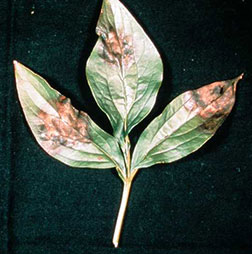 |
Previous Issues |
| Cedar Mill Community Website |
|
Search the Cedar Mill News: |
About The Cedar Mill News |
|
|||||||
| Volume 15, Issue 11 | November 2017 |
||||||
Fall care for peonies
|
||||
 |
| Botrytis blight on a peony leaf. From Missouri Botanical Garden. |
However, do not allow the leaves to remain on the plants after they fade. Fungal diseases, Botrytis blight being the most common, destroy the flowers and some leaves in the spring. Funguses overwinter on the foliage and the best and easiest way to avoid them is to cut all leaves and flower stems just below the soil surface and dispose in the trash. Do NOT compost! Do this as soon as foliage and flower stems dry out and fade.
This removal is imperative! I learned a hard lesson when I neglected to do this task in 2015. The following spring, I noticed some withered foliage on my plants and shriveled blackened flower buds that died. I removed these diseased parts as soon as I saw them but only a few flowers were healthy that season. By the time botrytis is visible, no amount of fungicide will cure it because it is already internal. What a disappointment to lose my chance to have peonies, one of my favorite flowers! Last fall I was more vigilant and removed not only all foliage and flower stems but also a bit of the surface soil to make sure all trace of fungus spores were gone. This spring my flowers were healthy and beautiful as usual.
Fall is planting and dividing time for peonies. Make sure there are at least two or three ‘eyes’ or growth buds on divisions. Eyes are pointed and pink and should be planted with the eyes no deeper than two inches under the soil. Add a generous shovelful of compost and choose a sunny well-drained spot. Peonies are drought tolerant when established and require little care beyond removal of foliage in the autumn. The rewards are great when the glorious and often fragrant flowers open in May and June.
Questions? Email me at margierose2@gmail.com or call 503-645-2994.
![]()
Like us on Facebook for timely updates
Published monthly by Pioneer Marketing & Design
Publisher/Editor:Virginia Bruce
info@cedarmillnews.com
PO Box 91061
Portland, Oregon 97291
© 2017